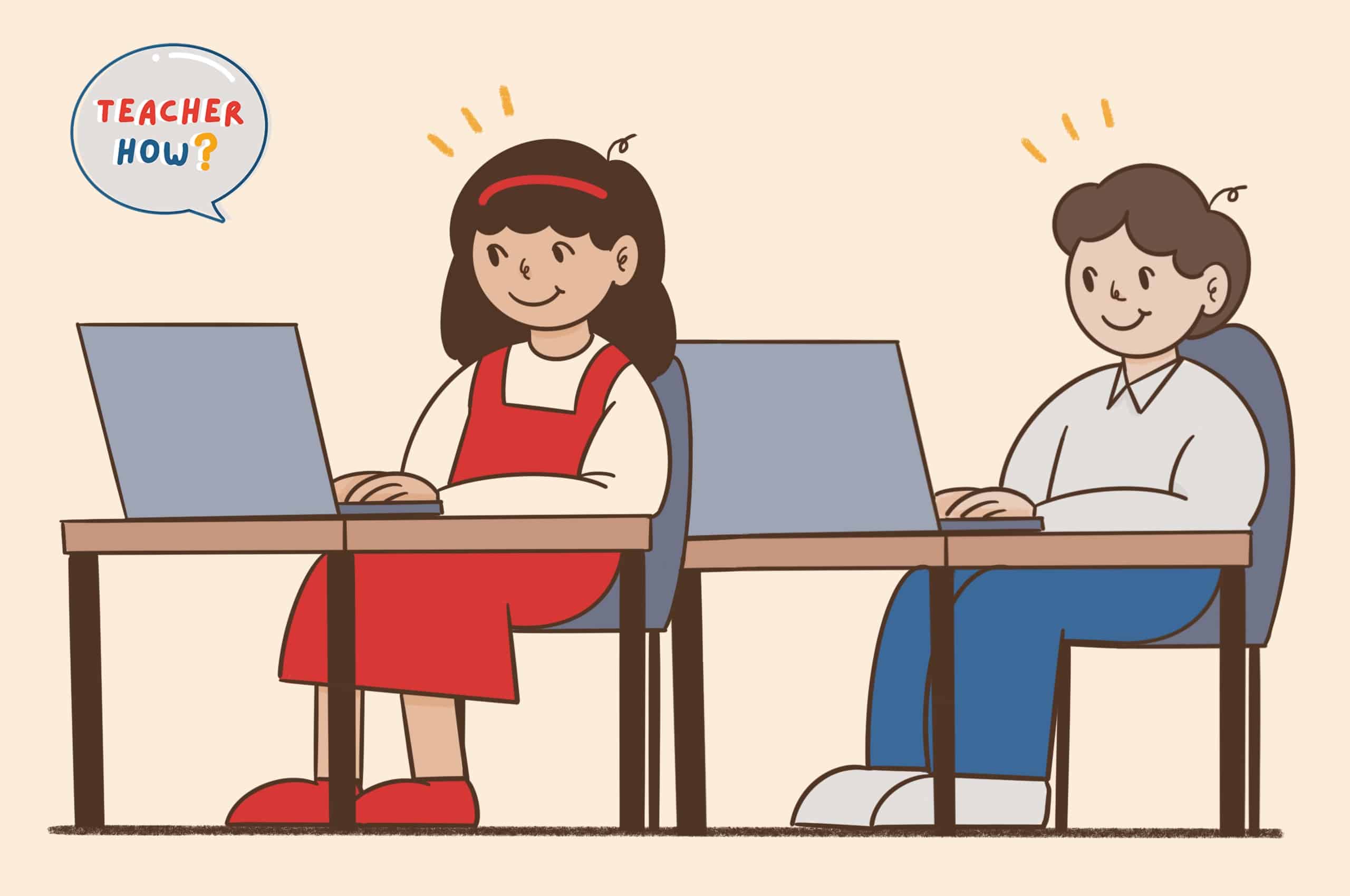Having realized the vast potential of using technology to enhance learning, innovative teachers aspire to incorporate online tools and platforms into the classroom. Yet, for some educators, the worry of managing the appropriate use of technology is still a significant issue holding them back from implementing more ICT in class.
Here are ten practical ways how teachers can ensure that students are using technology more responsibly:
- Set clear expectations.
- Effective classroom setup.
- Familiarize yourself with the technology beforehand.
- Monitor student usage.
- Use technology as an incentive.
- Teach and practice research skills.
- Get parents involved.
- Promote student contributions.
- Take regular breaks.
- Reflect and adapt.
Understanding and implementing these points will not only reduce poor conduct but should also lead to an increase in student engagement. So, let’s explore!
1. Set Clear Expectations
Like classroom management in general, setting clear guidelines on how you expect students to conduct themselves while using technology is paramount.
For the current generation of children, technology is everywhere. And we might be excused for thinking that they are comfortable navigating their way through anything automated.
Still, however tech-savvy they may appear, there must be directives to ensure technology’s safe and efficient use.
An open discussion with your students, where they are sharing their thoughts and ideas on the subject, can be tremendously meaningful. Things to talk about can include:
- Being on task while using technology
- Taking care of devices and equipment
- Staying clear from inappropriate content
- How to communicate with others online
- Avoiding plagiarism and copyright
At the end of these discussions, make sure that you and the students arrive at a clear understanding of the expectations.
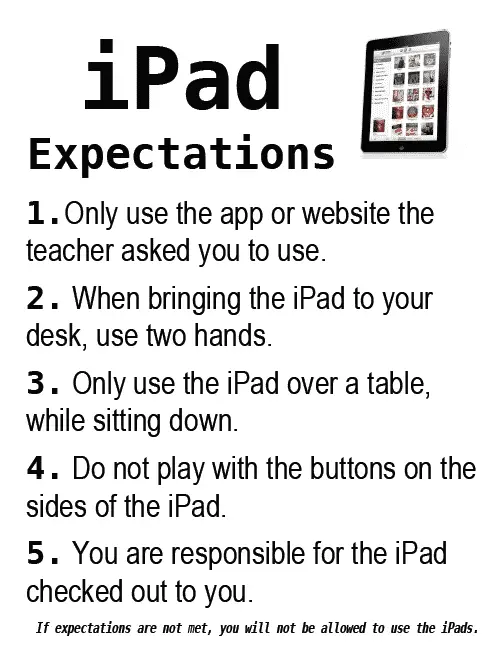
 )
)Creating a display board and outlining the agreed points would help reinforce this.
Irresponsible use of technology is no light issue. Those in class can be putting themselves and others at risk, not to mention the detrimental effect on learning. Therefore, pupils should also be aware of the consequences of not following set agreements.
A quiet word is often enough to steer children back on track. However, if this doesn’t work or severe misconduct occurs, let students know that their privileges of using technology in class can be scaled back.
NOTE – If this repercussion is implemented, the teacher must have an alternative solution on how the student can still access and demonstrate the learning without needing technology, e.g., a printed worksheet with equivalent instructions and tasks.
Laying solid foundations on proper technology use is extremely helpful for children and will save teachers a great deal of stress.
2. Effective Classroom Setup
Putting thought into how you set up your classroom will also contribute to a more trouble-free experience when it comes to technology use.
A well-thought-out seating arrangement should not be underestimated. Start by positioning desks and workspaces to allow the teacher to see as many student devices as possible.
A conventional classroom would often have the teacher’s desk at the front, with the writing/interactive board behind them. And naturally, most students will be facing the front, eagerly and attentively following the lesson.
The drawback with this setup is that while you can see your pupils’ faces, you most likely cannot see their screens.
Where possible, I try to deliver instructions from the back of the class. That way, as students work away on their devices, I have an excellent field of vision that allows me to attend to students I see needing help and scan screens to spot any likely deviators.
Furthermore, a seating plan can be equally effective in managing the appropriate use of technology in class.
As teachers, we know the individuals we need to keep a closer eye on – the ones with a slightly higher potential of disrupting the flow of learning. Having them seated next to classmates who are less likely to distract or be distracted is enormously helpful in reducing disturbances to the lesson.
A final tip related to your classroom setup involves making any IT info that students need during the lesson clear and accessible. This should include login details and website addresses, at the very least.
It is common now for classes to connect to and work with various educational websites and tools. Remembering where and how to log in to each online platform is no easy chore.
To make things considerably easier for your students – and indeed, for yourself – you can create individual cut-outs for each child, displaying their username and password needed for websites/apps used often in class.
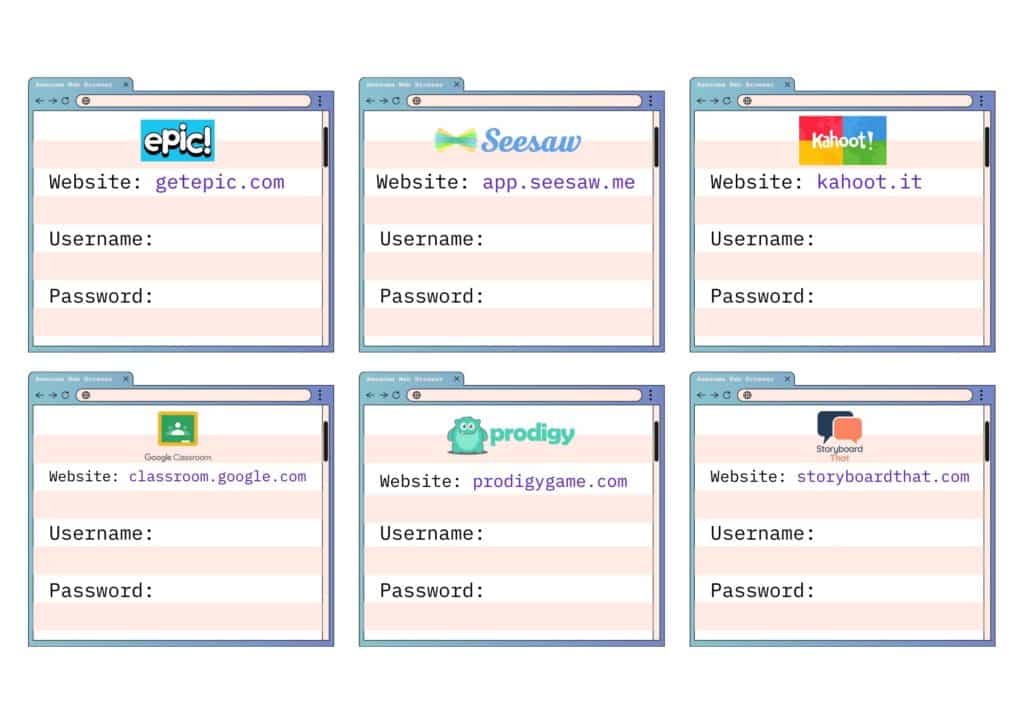
This modest action allows students to begin their tasks immediately, decreases their reliance on you, and minimizes the likelihood of students being off track due to their inability to access the necessary platform.
3. Familiarize Yourself With the Technology Beforehand
Every day it seems like there are new and revolutionary online tools that claim to radically aid your teaching and boost your students’ educational attainment.
While I firmly believe in the immense capacity of using technology to enhance learning, endeavoring to utilize every digital platform is unrealistic and unproductive.
Instead, teachers should concentrate their time and efforts on getting to grips with a manageable amount of technology.
If the technology in question is a device, then get your hands on the gadget. ‘Accessibility’ in the Settings menu is a good place to start. Here I discovered features like text-to-speech, screen magnifier, BeeLine Reader, and many more tools that have helped me engage students with different needs and learning styles.
If you plan to use a website or an online educational service, be prepared to spend a reasonable amount of time exploring and unpacking it.
Things like child-friendliness, pricing, relevance to the syllabus, potential tasks and activities that can be created, etc., should become apparent the more you navigate through the online tool.
On a more formal note, familiarizing yourself with technology may be necessary to avoid breaching legal regulations. Data reforms like GDPR are put in place to protect the personal information of individuals, including young children. So be sure to check with your school’s administration to verify if and how you can employ a particular website/online service.
4. Monitor Student Usage
You have set clear expectations on using technology in class and mastered the effective classroom setup; the job’s done? Not always.
Seasoned teachers will insist that technology, amongst other things, offers them more control in class.
Something that has proven considerably successful for me is Apple Classroom. With this tool, a teacher has essentially complete control over students’ devices in real-time and allows them to perform actions like:
- Viewing a student’s screen
- Opening any app or website on a student’s device
- Locking a student’s device entirely
Your students are far less likely to be misusing their devices knowing the level of oversight their teacher has.
There is also a novelty element of such a cool application. Students marvel at the operation of Apple Classroom and are left in awe and disbelief, enough to have them hooked on your message.
To some, however, Apple Classroom may come across as too infringing and constraining, where students feel restricted. This is a valid critique, yet, when used with balance, its effectiveness in encouraging the responsible use of technology is irrefutable.
I would often introduce Apple Classroom at the start of the academic year and find that after just a month of use, I no longer need to rely on the tool as the students steadily develop responsible habits.
Note – Apple Classroom, as the name suggests, is only compatible with Apple devices.
To see how Apple Classroom can be used in class, watch this video:
It’s not just about reducing the temptation for misconduct. It is worth highlighting how technology also allows teachers to track and target students who appear to need more consolidation and support.
Luckily, most educational websites contain a ‘Teacher Dashboard’ page with a multitude of helpful information.
Take, for example, Prodigy , a platform where students create characters that can earn stars and upgrades by solving math problems – a big hit with my pupils!
, a platform where students create characters that can earn stars and upgrades by solving math problems – a big hit with my pupils!
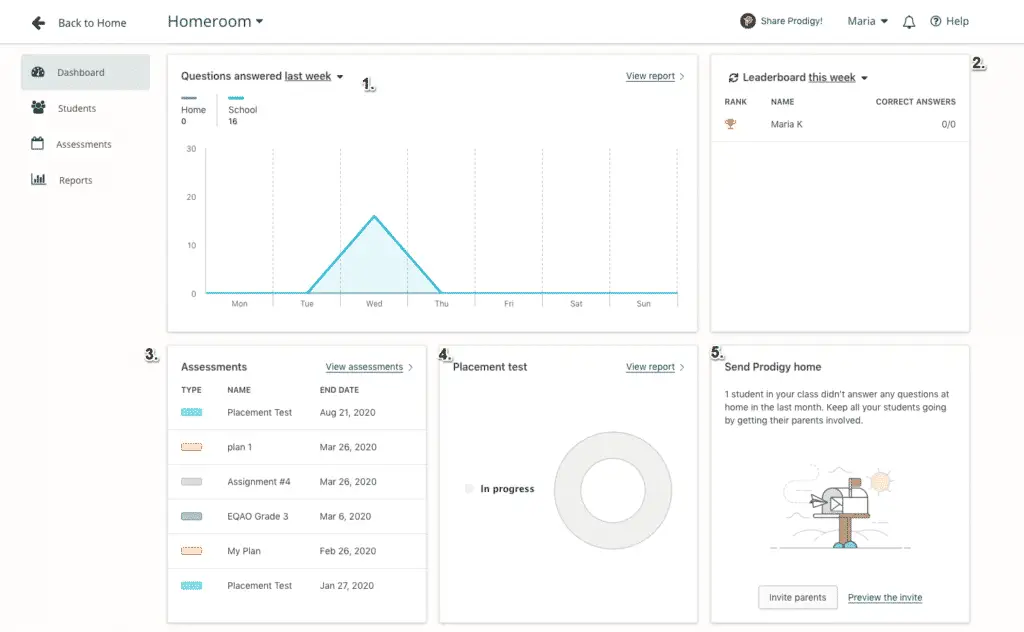
On the website’s Dashboard screen, a teacher will find an in-depth analysis of how each student is progressing with the questions set and how long each student is spending on the platform.
The latter is especially beneficial as we can see the time spent on answering math problems and match this against the allotted time during the lesson.
Another such example is Epic . With a vast catalog of books, this digital reading platform is another firm favorite. And like with Prodigy, it allows teachers to track student usage time.
. With a vast catalog of books, this digital reading platform is another firm favorite. And like with Prodigy, it allows teachers to track student usage time.
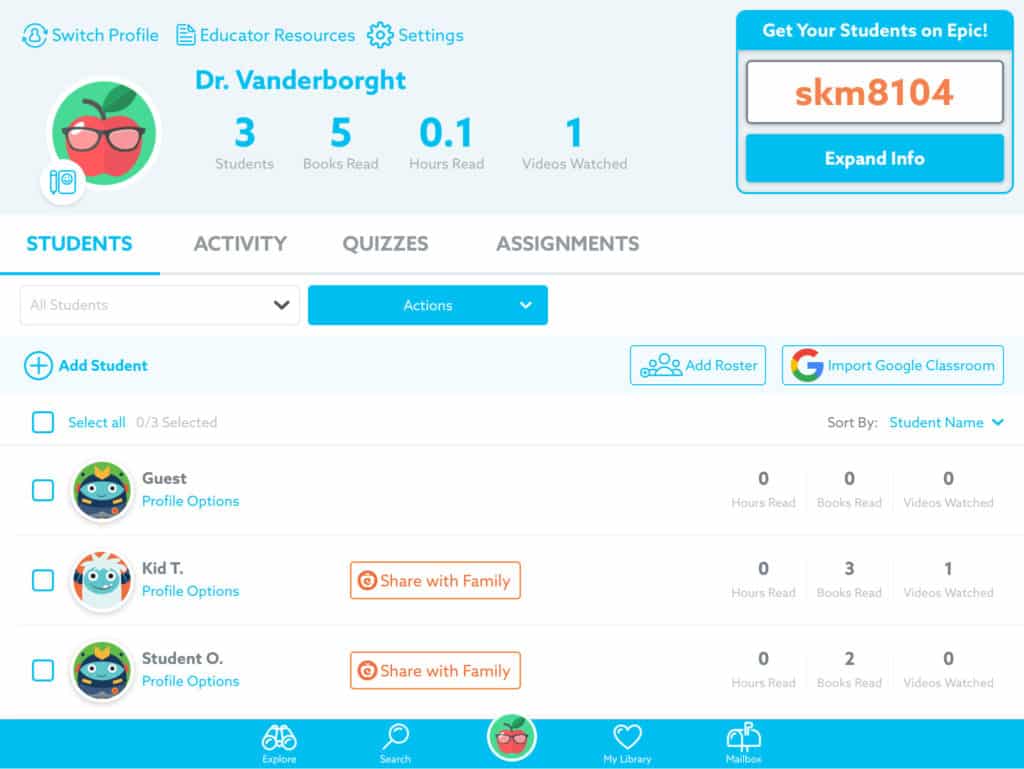
But what’s more, you’ll also be able to see precisely which books your students are exploring, meaning that you can intervene if you want to nudge them toward particular reading material.
5. Use Technology as an Incentive
It is no secret that students love using technology. Whether it’s for reading, writing, or presenting, they would rather get their hands on an iPad than a textbook.
In some schools, devices have to be shared amongst several classes, where a booking system or a rota is often in place. If you are familiar with this, you should be able to relate to how the class reacts to the sight of the laptop trolley being wheeled in. The sheer thrill of knowing that technology will be used in that lesson is unmatched.
I have been lucky to work at schools where every student has access to their own device throughout the day.
My students would know that not all lessons require or warrant the use of technology. But I would often slip in the possibility of using our devices for an upcoming activity and watch as the students’ eyes light up with anticipation.
Certain websites/apps, in particular, can have your students eating out of your hand. These include:
- Kahoot
- Blooket
- Gimkit
- Prodigy
- GetEpic
- Code.org
Seeing how technology excites and motivates students, teachers can use this to induce the desired behavior: one of responsibility and maturity.
A student knowing that good behavior is likely to result in greater use of technology will certainly try harder to follow your expectations.
At the same time, pupils will become aware that misuse of technology can lessen their chance of screen time.
6. Teach and Practice Research Skills
Thanks to the internet, it can feel like students have the power of the world at their fingertips. So, practicing Research Skills will enable you and your students to harness that power.
For those experienced in the IB curriculum, the term ‘Research Skills’ should be very identifiable. It is one of the five pillars of the ‘Approaches to Learning Skills.’ ibo.org describes Approaches to Learning (ATL) as skills designed to enable students to “learn how to learn.”
describes Approaches to Learning (ATL) as skills designed to enable students to “learn how to learn.”
In short, Research Skills encompass the following:
- Formulating questions
- Planning
- Collecting data
- Recording data
- Organizing data
- Interpreting data
- Presenting research findings
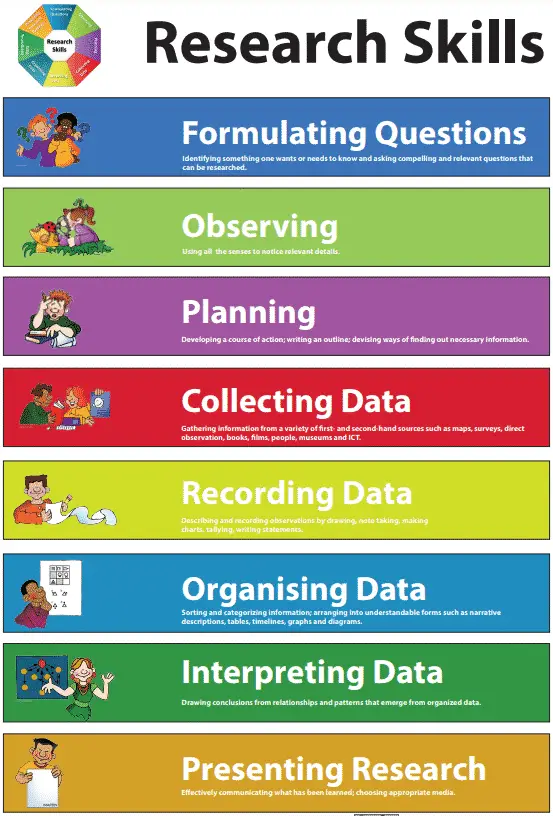
 )
)Even if you are not familiar with the IB curriculum, understanding and fostering the fundamentals of Research Skills will undoubtedly boost the responsible use of technology in your classroom.
Before the days of Google, those searching for information could pick up a relevant book and trust the teachings in the book to be accurate. Now, if we input the information we seek into a search engine, it would return an endless list of results, with little way of knowing fact from fiction.
Therefore, navigating through online obscurity is a skill worth teaching and practicing, especially when it comes to tasks requiring students to find information independently.
From a 2012 survey conducted by Pew Research , a large number of teachers rated their pupils poorly on research skills. The study also highlighted how most teachers believe that students should be taught these skills as early as elementary school.
, a large number of teachers rated their pupils poorly on research skills. The study also highlighted how most teachers believe that students should be taught these skills as early as elementary school.
Early in the academic year, I always dedicate lesson time to consciously teaching the correct process of researching online, which includes the following steps:
- Forming clear questions
- Judging the reliability and appropriateness of the source
- Retrieving relevant information
- Using other sources to corroborate the information
7. Get Parents Involved
Having the parents on your side should not be underestimated, and fortunately, technology can often do more good than harm in this regard.
From my experience, I have come across many websites and apps which offer the ability to connect with parents. Here are a few examples and how I try to get the best out of them:
Seesaw / Toddle
Although Seesaw and Toddle are different in many aspects, both are digital student portfolios, meaning that a running record of students’ work can be stored online.
Once parents are connected to the particular platform, they will have access to their child’s online portfolio, allowing them to see the learning taking place as well as the progress their child makes over time.
Another key feature of both programs is linked to communication, where sending and receiving messages from parents couldn’t be easier. Whenever I need to send a quick whole-class notice to students and parents, Seesaw or Toddle would be my desired line of communication due to the relative simplicity.
I also find that communicating with parents via these platforms can be done more informally, easing the tension for both parties.
Here is a video showing how Seesaw appears and functions from the parent’s perspective:
Class Dojo
Teachers who use or know about Class Dojo will be aware that it is an excellent tool for classroom management, where students receive – and can lose – dojo points for their behavior in class. It has plenty of other practical features like random student selection and even an onscreen noise meter, so I find that I am opening the Class Dojo app several times each day.
Due to the platform’s usefulness, I decided to take the action of inviting parents to connect to their child’s account, which was a straightforward process in itself.
My main reason for getting parents involved through Class Dojo is to allow them to keep track of the dojo points their child has and even why they received or lost each point.
I found that students behaved more consciously with the knowledge that their parents could instantly be notified of how they were conducting themselves in class.
Plus, the customizable ‘Positive’ and ‘Needs work’ skills on Class Dojo let parents know what the teacher is looking for, so parents can support in reinforcing the classroom expectations at home.
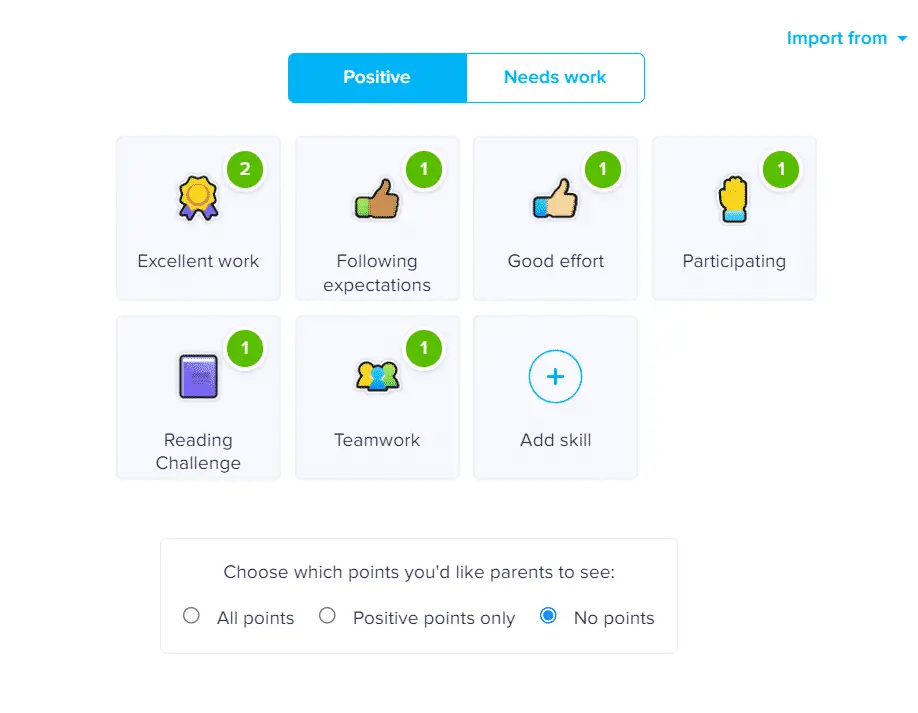
Rest assured, these settings can be changed so that the teacher can decide what parents see and do not see.
Teachers who create opportunities for parents to feel more involved in their child’s learning point to two important benefits. First, parents who are kept in the know are more likely to continue and reinforce schoolwork at home. Second, students are further encouraged to act more responsibly, knowing that their parents can also see their digital footprint.
8. Promote Student Contributions
Giving students the freedom to explore what different online websites/apps might have to offer falls under the umbrella of ‘student voice’ and ‘agency,’ which is about “empowering kids to own their learning through greater autonomy,” as defined by Eric Sheninger in Student Agency: Moving From Talk to Action .
.
Research on student voice overwhelmingly supports the notion that learning becomes more meaningful and relevant through activities that give students more choice and ownership in learning. Technology is no exception to this.
Handing some decision-making power to your students might seem counterproductive at first. However, when implemented under the right culture and conditions, you will quickly realize that you are doing yourself and, more importantly, your students a huge favor!
Here is a practical way this can be achieved:
When introducing new technology to your class – be it a new device, website, program, or app – let your pupils simply explore.
As they navigate, they will examine and discover aspects of the new technology for themselves, which is far more likely to stick with them than if you showed it without much context.
How this might look in my classroom if I wanted to introduce a new app:
- Reveal the app’s icon and ask students if they have any prior knowledge about it.
- Use Apple Classroom to ‘Open’ the new app on students’ iPads and use the feature ‘Lock in app after opening’ for added assurance.
- Give them a set time (usually 5 or 10 minutes) to explore the app as they choose.
- After the independent task, ask them to collaborate and share what they might have discovered with a partner.
- Ask them to demonstrate something they have discovered to the rest of the class.
- Finally, get their thoughts and ideas on how the new app could be used in connection with particular learning or subject.
If the students have access to the device at home, you can achieve similar results – if not better – by assigning the task as homework, giving them more time and flexibility to delve into the new app.
To generate extra enthusiasm and excitement, brand the session as an ‘IT show and tell’ and have the class vote on the top 3 most useful ideas shared.
Students will often surprise us with the knowledge and skills they acquire outside of what we teach them. None more so than when it comes to technology. So be bold and put some more trust in your students.
9. Take Regular Breaks
My students are quick to remind me that “if you stare at the screen for too long, your eyes will go square,” or something to that effect.
When using technology, we are often confined to our desks, and the consequent lack of movement harms our bodies and mind.
Neuroscience research by Professor Deborah Stevens-Smith finds a link between movement and the benefits it may have on a developing brain. Such benefits consist of:
finds a link between movement and the benefits it may have on a developing brain. Such benefits consist of:
- Students being more likely to process and retain information
- Students feeling less anxious and stressed
- Students get the opportunity to develop social skills
- Students building on their self-esteem and a sense of belonging
However essential and engrossing an online activity may be, spending a lengthy period on a device will naturally lead to a loss of focus and engagement, especially with younger children.
When this happens, students are much more likely to misuse the technology in their hands. Therefore, regular breaks that take us away from the screen are necessary.
The best way to achieve this is through ‘Brain Breaks’! These short, structured activities give children a brief rest from what they’re doing to help their brains shift focus.
Here are some tried and tested Brain Breaks that your students will love, and that do not require any use of technology:
- 3, 6, 9 – students count to 10 in sequence, but when they get to the numbers 3, 6, and 9, they have to perform an action rather than say the number.
- Silent Ball – students pass a ball around without making a sound. If the ball is dropped or someone speaks, they are out. To make things more interesting, you can introduce challenges like students can only use one hand to catch and throw, hop on one leg while playing, etc.
- Simon Says – a classic game where students have to listen carefully and only perform commands that start with “Simon Says…”.
- Draw over your head – students put a whiteboard on their heads. The teacher mentions an object to draw, and students have to draw it as best they can… with the whiteboard planted on top of their heads.
10. Reflect and Adapt
Learning should never stop. That is why great teachers continually reflect on and improve how they do things.
You are taking active steps to advance your practice and setting an excellent example for your students to follow now and in the future.
As teachers, we can often gauge the level of interest our students have in the activities we set. If students enjoy a particular task or tool, they will often vocalize their satisfaction. This is extremely healthy and should be promoted by the teacher, not thwarted.
Teachers should actively seek feedback from their students regularly, and the responses should shape their planning.
Again, technology can be our friend when collecting such feedback. I would often create and send a Google Forms questionnaire to my students and ask them to be as honest as possible.
Possible technology-related questions to ask students may include:
- Which online tool did you most enjoy using and why?
- Which online tool did you least enjoy using and why?
- What was your biggest challenge with the technology we used in class?
- Write two questions you have about the technology we used.
- What can we do to improve the technology we use in class?
If students feel like their opinions matter, they will have little reason not to act responsibly when completing a task they enjoy.
In particular to technology, make it a habit to evaluate the value the online tool has brought into the class. If something has not worked well for whatever reason, there are alternative programs or approaches one could take to achieve better results.
In an ever-changing digital world, teachers must stay updated with technological advancements. Hence, continually be on the lookout for new online tools that can potentially enhance the teaching and learning in your classroom.
Here are two websites that I would recommend checking out and bookmarking:
Conclusion
It is now more critical than ever that teachers feel secure about incorporating more technology in class and encouraging students to use it responsibly.
If you are fortunate, your school or district will provide valuable training and opportunities for you to develop your IT proficiency and implement the recommendations mentioned in this article.

